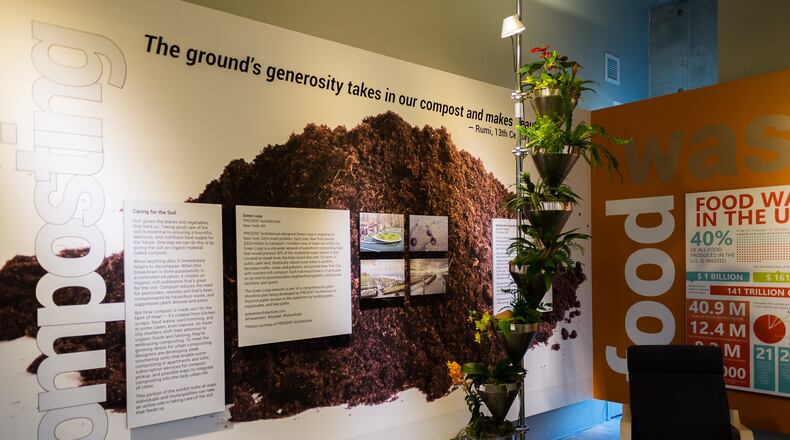In the future, we will eat baked goods made from pulverized crickets, subsist solely on liquid diets of protein shakes, grow basil in living room pods with timers that alert us when the growing cycle is over and tend gardens in inner-city concrete mediums.
And in the Museum of Design Atlanta exhibition “Food by Design: Sustaining the Future,” the future is now. All of those things and far more fascinating food-centric projects are already a reality as scientists, students, architects, activists and gardeners visualize how to grow and prepare food in a changing world.
Related: Exhibit, restaurants dish out sustainable innovations
Curated by MODA executive director Laura Flusche, “Food by Design” is a compelling mix of projects that have realized a sci-fi future today, like growing meat from animal cells as an antidote to environmentally destructive, cruel factory farms or crafted from bricks formed out of compost. The crux of “Food by Design” is new ways of thinking about growing food, reusing food waste, cooking, marketing and selling food as issues like obesity, food inequality and unsustainable farming methods inspire a re-evaluation of food-related issues.
Also in the mix are inspiring projects for handling sustainability, waste and limited growing space in urban environments like New York firm Present Architecture’s Green Loop proposal to create waterfront composting hub islands off of Manhattan’s waterfront or a London project that turns former underground bomb shelters into urban farms.
Because 80 percent of the population now lives in cities, urban agriculture and growing food in small spaces is a consistent feature of “Food by Design.” British artist Vanessa Harden’s Subversive Gardener line on view at MODA is a cheeky product line that embeds gardening tools like rakes, hoes and seed spitters into fashion and accessories like ball caps and rings, for guerrilla gardening on the go.
Part of the fun of Food by Design is its immediacy and relatability. We all eat, after all. That accessibility is balanced by the exhibition’s text-heavy design and preponderance of photographs in place of objects, which suggests this information could be conveyed just as well in book form or on a website. To be sure, there are a number of compelling examples of food innovation on display, like a complex indoor growing system designed by Amy M. Youngs in which a tower of growing pods allow the user to compost, grow and hydrate in one self-contained system whose watering component is a pump located in a rocking chair you have to rock to activate.
A number of the projects in “Food by Design,” from a Georgia Tech grad’s food-substitute innovation Soylent to Atlanta compost organization Compostwheels, have Atlanta roots, many of them spearheaded by ordinary citizens and by the city’s first Urban Agriculture Director Mario Cambardella.
It turns out a city once held up by academics and urban planners as the depressing poster child for urban sprawl seems to have turned a corner and is now doing its part to address health issues, food scarcity, waste and poverty with innovative solutions. “Food by Design” affirms that — thanks to city government, institutions like Georgia Tech and some truly committed, progressive citizens — Atlanta is shaping the future in a productive, thoughtful way, from pop-up green markets in MARTA stations to a city plan to grow gardens in the unused areas around power lines.
In the end, the future looks like it is in good hands, if these innovators are on the case.
ART REVIEW
“Food by Design: Sustaining the Future”
Through May 7. Noon-6 p.m. Tuesdays-Wednesdays, Fridays and Sundays; noon-8 p.m. Thursdays; 10 a.m.-6 p.m. Saturdays. $10, adults; $8, seniors, military, educators; $5, children ages 6-17 and college students; free for children 5 and under and members. Museum of Design Atlanta, 1315 Peachtree St. N.E., Atlanta. 404-979-6455, www.museumofdesign.org.
Bottom line: Projects both whimsical and practical define these innovators in food’s future.
About the Author
The Latest
Featured





